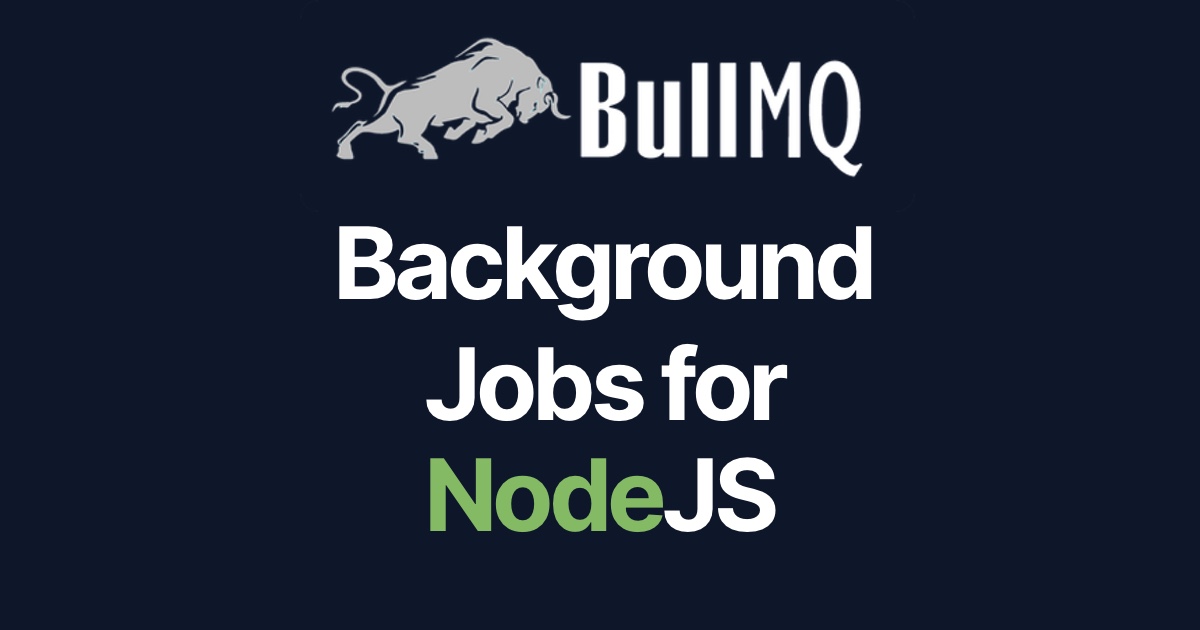Reliable Background Task Execution using BullMQ and Node.js
 Gaurav Kumar
Gaurav Kumar
In modern Node.js applications, ensuring smooth background processing is crucial for maintaining responsiveness and scalability. Message queues offer an effective solution, decoupling message production from consumption and enabling asynchronous task handling. BullMQ, a popular choice, provides a robust and efficient way to implement message queues in your Node.js projects. This article guides you through integrating BullMQ for reliable background processing
Understanding Message Queues
Imagine a conveyor belt, producers place tasks on the belt (queue), and separate worker processes (consumers) pick them up for execution. This asynchronous approach decouples producers and consumers, allowing them to operate independently without hindering each other's performance. Message queues offer significant advantages:
Scalability: Effortlessly scale producers and consumers to manage increasing workloads.
Resilience: Tasks persist in the queue, ensuring delivery even if producers or consumers encounter temporary outages.
Asynchronous Processing: Producers don't have to wait for tasks to finish processing, leading to a more responsive application.
Fault Tolerance: Queues automatically retry tasks upon failures, enhancing system reliability
Getting Started with BullMQ
Installation:
Begin by installing the
bullmqandioredispackages using npm:npm install --save bullmq ioredisbullmqprovides core functionalities for managing queues and jobs, whileioredisacts as the Redis client library.Connecting to Redis:
We are going to use a self-hosted Redis server, download redis from here and install it in your system https://redis.io/downloads/
const Redis = require('ioredis'); const redisConfig = const redisConnection = new Redis({ port: 6379, // Replace with your Redis port if different host: '127.0.0.1', // Replace with your Redis host if different }); module.exports = redisConnection;This code defines the Redis configuration and creates a connection object.
Creating a Queue:
Import the
Queueclass from BullMQ and your Redis connection in your main application file (e.g.,index.js)import {Queue} from 'bullmq'; const commentNotificationQueue = new Queue('comment-email-notification', {connection: redisConnection});Here, you create a new BullMQ queue named
comment-email-notification. Theconnectionproperty specifies the Redis connection established earlier.
Adding Jobs to the Queue
Job Data:
Jobs in BullMQ consist of data you want to process asynchronously. This data can be anything relevant to your task, such as file paths, user IDs, or API request parameters.
Adding a Job:
Use the
addmethod on your queue instance to add a new job:async function addJobs() { const comments = [ { "text": "I really enjoyed your article on machine learning! The explanation of different algorithms was very clear and concise. Keep up the good work!", "commenter_name": "John Smith", "commenter_email": "john.smith@example.com", "author_name": "Jane Doe", "author_email": "jane.doe@example.com" }, { "text": "This phone is amazing! The battery life is fantastic, and the camera takes stunning photos. I would highly recommend it to anyone looking for a new phone.", "commenter_name": "Sarah Lee", "commenter_email": "sarah.lee@example.com", "author_name": "Stephan Josh" }, { "text": "Thanks for your insights on the future of AI. I agree that ethical considerations are crucial as this technology advances.", "commenter_name": "David Kim", "commenter_email": "david.kim@example.com", "author_name": "Michael Brown", "author_email": "michael.brown@example.com" } ] for (const comment of comments) { await commentNotificationQueue.add(comment?.commenter_name, comment); } } await addJobs();This code adds a job named based on
commenter's namewith the specified data (jobData) to thecomment-email-notificationqueue.Job Options (Optional):
BullMQ offers various options for customizing job behaviour:
delay: Schedule the job for execution later (in milliseconds).attempts: Define the number of retries for failed jobs.backoff: Set a backoff strategy for retries after failures (e.g., exponential delay).priority: Assign a priority value to jobs (higher values are processed sooner).
These options provide granular control over job processing and error handling.
This is how the jobs are stored in the Redis database:

Consuming Jobs (Workers)
Worker Creation:
Workers are Node.js processes that continuously listen for new jobs in a queue and execute them. Create a worker using the
Workerclass:const commentNotificationWorker = new Worker('comment-email-notification', async job => { const {commenter_name, author_name} = job?.data; // process comment and send email to author's email about the new comment that he/she receives console.log(`${commenter_name} commented on ${author_name} article`) }, {connection: redisConnection});This code defines a worker for the
comment-email-notificationqueue. The provided asynchronous function (async (job) => {...}) will be executed for each job received by the worker. Remember to replace the placeholder comment with your actual business logic that utilizes thejob.dataproperty.Test the worker:
This is the output of the worker when the job is executed from the queue

Here is the link to the source code: https://github.com/icon-gaurav/nodejs-bullmq-implementation.git
Subscribe to my newsletter
Read articles from Gaurav Kumar directly inside your inbox. Subscribe to the newsletter, and don't miss out.
Written by

Gaurav Kumar
Gaurav Kumar
Hey! I'm Gaurav, a tech writer who's all about MERN, Next.js, and GraphQL. I love breaking down complex concepts into easy-to-understand articles. I've got a solid grip on MongoDB, Express.js, React, Node.js, and Next.js to supercharge app performance and user experiences. And let me tell you, GraphQL is a game-changer for data retrieval and manipulation. I've had the opportunity to share my knowledge through tutorials and best practices in top tech publications. My mission? Empowering developers and building a supportive community. Let's level up together with my insightful articles that'll help you create top-notch applications!